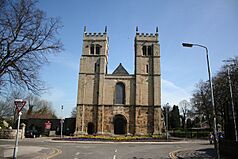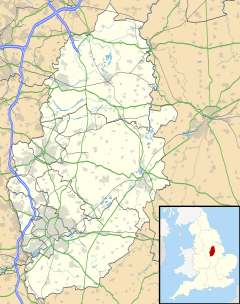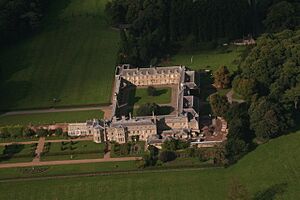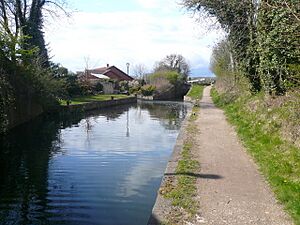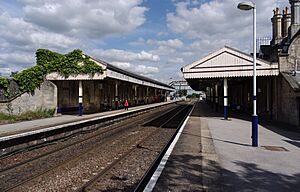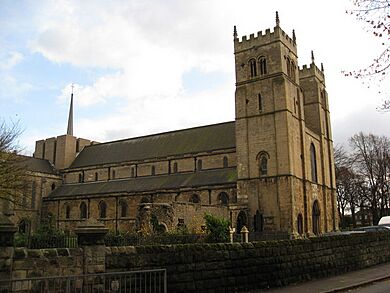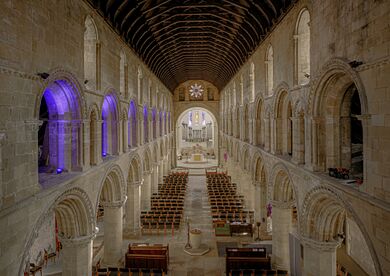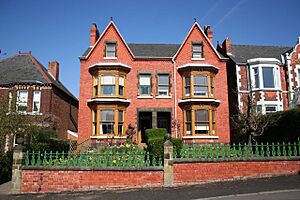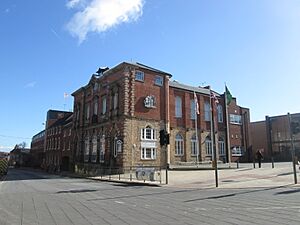Worksop facts for kids
Quick facts for kids Worksop |
|
|---|---|
| Town | |
|
|
|
| Population | 44,733 |
| Demonym | Worksopian |
| OS grid reference | SK 58338 78967 |
| District |
|
| Shire county | |
| Region | |
| Country | England |
| Sovereign state | United Kingdom |
| Post town | WORKSOP |
| Postcode district | S80, S81 |
| Dialling code | 01909 |
| Police | Nottinghamshire |
| Fire | Nottinghamshire |
| Ambulance | East Midlands |
| EU Parliament | East Midlands |
| UK Parliament |
|
Worksop (/ˈwɜːrksɒp/ WURK-sop) is a busy market town in Nottinghamshire, England. It is part of the Bassetlaw District. The town is about 15 miles (24 km) south of Doncaster and 24 miles (39 km) north of Nottingham.
Worksop is close to the borders of South Yorkshire and Derbyshire. It sits on the River Ryton and is near the northern edge of Sherwood Forest. In 2021, about 44,733 people lived in Worksop.
Contents
History of Worksop
Early History
Worksop's name probably comes from an old Anglo-Saxon name. It might mean "We(o)rc's valley." In the Domesday Book of 1086, Worksop was called "Werchesope." This book was a survey of England ordered by William the Conqueror.
After the Norman Conquest, Worksop became part of the lands given to Roger de Busli. Later, the land went to William de Lovetot. He built a castle and started the Augustinian priory around 1103.
Medieval Times
A small fight happened near Worksop in 1460. It was called the Battle of Worksop.
In 1530, Cardinal Thomas Wolsey visited Worksop. He was on his way to Yorkshire. Worksop Priory was closed in 1539 during the dissolution of the monasteries. Most of the priory buildings were torn down. Only the main part of the church and its towers were left.
By 1540, the old Worksop castle was almost gone. John Leland said Worksop was "a pretty market of 2 streets and fairly well built."
Worksop Manor was a prison for Mary, Queen of Scots in 1568. A new house was built there in the 1580s.
In 1674, records show Worksop had 176 homes. This made it the fourth-largest place in Nottinghamshire. About 748 people lived there then.
Modern Times
By 1743, Worksop had about 1,500 people. This grew to 3,391 by 1801. By the end of the 1800s, it had 16,455 people.
Worksop grew a lot because of the Chesterfield Canal, built in 1777. The Manchester, Sheffield and Lincolnshire Railway also came through in 1849. The discovery of coal under the town helped it grow even more.
The area around Worksop is known as the "Gateway to the Dukeries." This is because of the large estates nearby. These include Clumber House, Thoresby Hall, Welbeck Abbey, and Worksop Manor. They were once owned by powerful dukes.
Getting Around Worksop
Canals
Worksop is connected to the UK canal network by the Chesterfield Canal. This canal was built to move coal, stone, and other goods. Today, people use the canal for fun, like boating.
Trains
Worksop has a train station. It is on the Sheffield-Lincoln line and the Robin Hood line. Trains run to places like Sheffield, Lincoln, and Leeds. You can also catch trains to Nottingham.
Roads
Worksop is on the A57 and A60 roads. These roads connect to bigger highways like the A1 and M1. The A57 Worksop bypass opened in 1986.
Cycling
National Cycle Route 6 goes through Worksop. This route connects London to the Lake District.
Buses
Local bus services are run by Stagecoach East Midlands. You can take buses to nearby towns like Doncaster, Rotherham, and Chesterfield.
Education in Worksop
Worksop has many schools for different age groups.
Primary Schools
- Gateford Park Primary School
- Haggonfields Primary and Nursery School
- Holy Family Catholic Primary School
- Norbridge Academy
- Kingston Park Academy
- Langold Dyscarr Community School
- Prospect Hill Infant and Nursery School
- Prospect Hill Junior School
- Ramsden Primary School
- Redlands Primary and Nursery School
- Sparken Hill Academy
- Sir Edmund Hillary Academy
- The St Augustine's Academy
- St Anne's C of E Voluntary Aided Primary School
- St John's C of E Academy
- St Luke's C of E Aided Primary School
- Worksop Priory C of E Primary Academy
- The Primary School of St Mary and St Martin
Secondary Schools
- Outwood Academy Portland
- Outwood Academy Valley
- Worksop College
Further Education
- North Nottinghamshire College
- Outwood Post-16 centre
Healthcare
Worksop has Bassetlaw District General Hospital. It is part of the Doncaster and Bassetlaw Teaching Hospitals NHS Foundation Trust. The hospital helps about 33,000 people each year. It also handles about 38,000 emergency cases. Bassetlaw Hospital is a teaching hospital for the University of Sheffield.
Mental health services in Worksop are provided by Nottinghamshire Healthcare NHS Trust.
Worksop's Economy
Today's Economy
Worksop's economy today relies on service industries, making things (manufacturing), and moving goods (distribution). There are many distribution and manufacturing companies here. This means fewer people are unemployed than the national average.
Some big employers in the area include Premier Foods, Greencore, RDS Transport, B&Q, and Pandrol. The National Health Service (NHS) is also a major employer.
Old Industries
Long ago, most people in Worksop worked on farms. There were also mills for grinding corn and places for working with timber.
One special crop grown in Worksop was liquorice. It was first grown in the priory gardens for medicine. Worksop was famous for it until about 1750. A pub in Worksop is now named after this old industry.
Timber was also important because the area had many forests. Wood was used for railway sleepers and making furniture. Worksop was known for making Windsor chairs.
Brewing and Malting
Making malt (for brewing) became important in Worksop. The town has a long history of brewing beer. The historic Worksop and Retford Brewery was here. Today, smaller local breweries continue this tradition.
Coal Mining
At the start of the 1800s, Worksop was mostly farming. But then coal was found. By 1900, most people worked in coal mining. This provided thousands of jobs for many years.
The first coal mine was Shireoaks Colliery. Later, Steetley Colliery and Manton Colliery also opened. When the mines closed in the 1990s, many people lost their jobs. This caused some problems in the area.
Textiles
In the past, Worksop had a small cloth industry. There was a dye house and a place where cloth was dried. Later, during the Industrial Revolution, two textile mills were built. But they closed quickly and were changed into corn mills.
Places of Worship
Worksop has several historic churches.
Worksop Priory is an Anglican church. It was founded as an Augustinian priory in 1103. Monks from the priory created the Tickhill Psalter, a beautiful old book. After the monasteries closed, the townspeople were allowed to use the main part of the church.
St. Anne's Church is another Anglican church. It was built in 1911. It has an old pipe organ from 1852.
St. John's Church was built between 1867 and 1868.
St Mary's is a Roman Catholic church. It was built from 1838 to 1840. In 1913, Archduke Franz Ferdinand visited this church. He was assassinated seven months later, which helped start World War I.
Worksop also has a small community and prayer center for Muslims.
Local Media
Worksop gets local news from BBC and ITV. Local radio stations include BBC Radio Sheffield and Greatest Hits Radio South Yorkshire. The local newspapers are the Worksop Guardian and Worksop Trader.
Places to Visit
Mr Straw's House is a unique place. It was the home of the Straw brothers. They inherited it in the 1930s. The house stayed almost the same until the National Trust took care of it. Now, you can visit it and see how people lived long ago.
Clumber Park is a large country park south of Worksop. It has 3,800 acres of parkland. It's a great place for walks and outdoor activities.
Worksop Town Hall was first built as a corn exchange in 1851.
The Worksop War Memorial is a large monument. It remembers local people who died in World War I and World War II.
Famous People from Worksop
- A'Whora (George Boyle, b. 1996), a drag queen and TV personality.
- Maurice Bembridge (b.1945), a golfer.
- Bruce Dickinson (b.1958), the singer for the band Iron Maiden.
- Alexina Graham (b.1990), a model.
- Gwen Grant (b.1940), a writer.
- Sarah-Jane Honeywell (b.1974), a BBC Children's TV presenter.
- William Henry Johnson (1890–1945), who received a Victoria Cross for bravery.
- Mick Jones (b.1945), a famous football player.
- John Parr (b.1954), a musician.
- Donald Pleasence (1919–1995), an actor.
- Graham Taylor (1944–2017), a former manager of the England football team.
- Lee Westwood (b.1973), a golfer.
See also
 In Spanish: Worksop para niños
In Spanish: Worksop para niños


